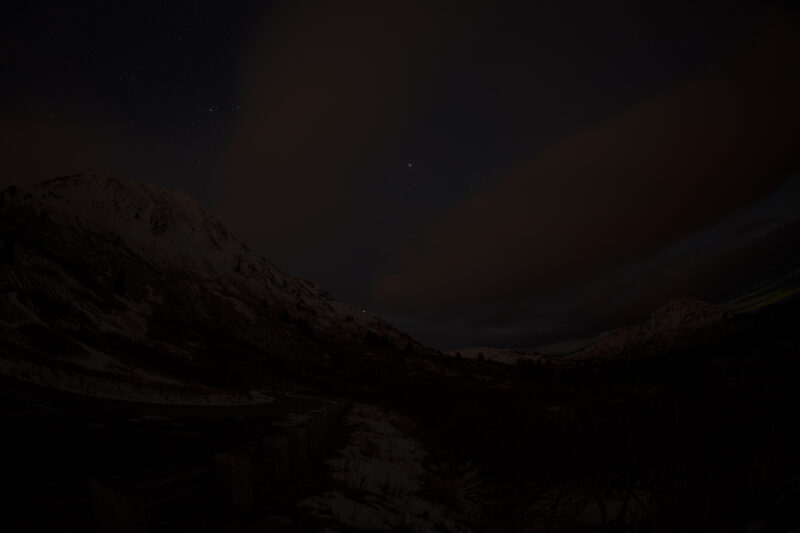Exciting photo, eh?
Yeah, I know. But taking the image sent me on a little journey for which I’m grateful. You see, I needed to know a “why.” And it took a National Geographic article about gardens to teach me a lesson in night photography…
As I stood on the side of the road, guard rail on one side and a cliff leading to the ocean on the other, I had second thoughts about leaving the comfort of a warm chair near the woodstove to drive out the road in search of northern lights. The aurora forecast, on a scale of 1 to 10 was a “5”; full of promise, but all I could see was a faint eyelid of green spying above the horizon.
Thankfully, stars outlined the snow-capped peaks and clouds in front of me, but without light from the still-low gibbous moon, the landscape was, to my naked eyes and brain, dull, dark and dimensionless, like the photo above.
Not very encouraging. Since I was already outside, dressed in layers for 10 degrees F, I decided to make a few pictures anyway, because, well, you never know — a mantra I use for those wedges of doubt. I snapped on a flashlight to locate a safe place in the gravel for setting up my tripod. Pulling off my gloves, I went through the motions of composing the scene through the viewfinder, using the flashlight to visually mark the corners of the image.
I squeezed the cable release and exposed a frame for 25 seconds. After the camera whirred for a bit, I pressed the preview button and was pleasantly surprised at what I saw: a pair of pink, oval clouds, pointing like giant sausages to the mountain ridges below. And to the right, oh so faint, but clearly there, green bands of the aurora connected heaven and earth.

What a surprise. I would never have guessed that such color and shapes existed in the mountain valley that night. It was another valuable lesson in how to think like a camera. [Canon 5D Mark II, 180-degree fisheye lens, f/2.8, ISO 3200, 25 seconds]
The next day, I spotted the April 2013 issue of National Geographic on the coffee table and paged over to the “Night Gardens” piece by Cathy Newman. It began with, “The sun vanishes. The pearl of a moon rises. Magic happens.”
I’m writing this because Cathy helped me understand the magic that unfolded on that moonless night above the ocean.
“Color is mostly irrelevant in a night garden. Because of how the eye sees, even the most incendiary reds and oranges turn into a monochrome of silver and grays under the waning moon. The retina, the sensitive lining of the eye’s interior, is layered with photoreceptive cells called rods and cones. Rods, which detect the intensity of light, can sense low levels of illumination. But cones, which distinguish color, require a threshold of light higher than provided by the fading moon. In the absence of that threshold, color washes away. (The long exposure and sensitivity of digital imaging do what the retina cannot, which is why we see color in these photographs.)
How wonderful it feels to discover answers in unexpected places.




No Comments
Helen Raschick
April 16, 2013 at 2:26 PMGreat lesson! Oh, the possibilities!
marionowen
April 16, 2013 at 2:56 PMYes, Helen… many possibilities. Such is life, eh? Have a great day!